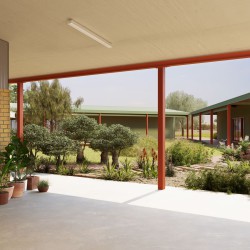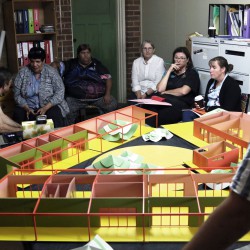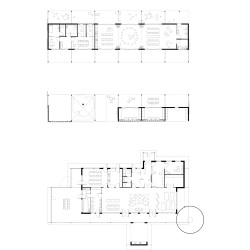Guillermo Fernández-Abascal (GFA2, UTS) . Urtzi Grau (Fake Industries. UTS) . Campbell Drake (CD Studio, UTS) . renders: © Choirender
The Murrin Bridge Preschool and Community Hub is a new civic centre for the community. The intervention will expand the existing school, recover public services recently relocated to Lake Cargelligo (health providers and Land Council offices), and relocate the REDIE and Centrelink offices currently based in a derelict building in the Aboriginal station.
The project started with a series of design consultation workshops with the future users of the centre, service providers and the preschool´s staff and students. This process identified four strategies that eventually guided the proposal: (1) preserve the existing building; (2) place all new structures around a courtyard; (3) surround the buildings with a verandah; and (4) take advantage of the local knowledge and construction technologies.
Three buildings surrounding a triangular courtyard define the final design. The first, the existing preschool, only requires minor improvements such as connecting the kitchen and the dining room, and adding a gallery space and an outdoor kitchen. The second is a 33m long and 12m wide pitched roof barn that houses the school extension and the community hub’s associated programs. Flanked by two 3 m deep verandahs, it is built using off-the-shelf construction solutions typical to local agricultural sheds. The third building is a covered area that hosts the kids’ outdoor playground and three storage rooms.
Inside the triangular courtyard, a circle encloses a fire pit, three mounds and several trees. Around the circle is a sensory garden, cool garden and civic garden. The first (sensory) is the school’s main playground and the entrance for students to arrive by bus; the second (cool) connects the existing school with its new extension; and the third (civic) opens to Murrin Bridge and the community hub.
The architecture of the Murrin Bridge Preschool and Community Hub could appear like a conventionally rural barn, or, like a banal industrial shed. Working with familiar materials and building types of the area is a purposeful decision. The more recognizable the building becomes to its future users, the more it reveals its specific character as both a school and a community centre. Playfully subversive, the building has the ability to adjust its identity, adopting a serious and formal civic role whilst at other times being comfortable, relaxed and childish. We believe that this controlled ambiguity is the best response to the complex project brief. Each step in the design process included the enthusiastic participation of the Murrin Bridge Local Aboriginal Land Council, the staff and students of the preschool, and the different service providers to imagine what lies ahead for the preschool and community hub collectively.
_
Team: Guillermo Fernández-Abascal, Urtzi Grau and Campbell Drake with Eduard Fernàndez, Jack Cooper, Saskia Schut, Louisa King, Charles Choi, Hamish McIntosh and Allan Teale from the University of Technology Sydney.
Architecture: Guillermo Fernández-Abascal (GFA2, UTS), Urtzi Grau (Fake Industries. UTS) and Campbell Drake (CD Studio, UTS) with Eduard Fernàndez and Jack Cooper
Landscape: Saskia Schut and Louisa King with the rest of the team.
Other Collaborators: TTW, Multiplex, HDC Planning, Certified Energy, Prism Facades
Images by Charles Choi (Choirender)










